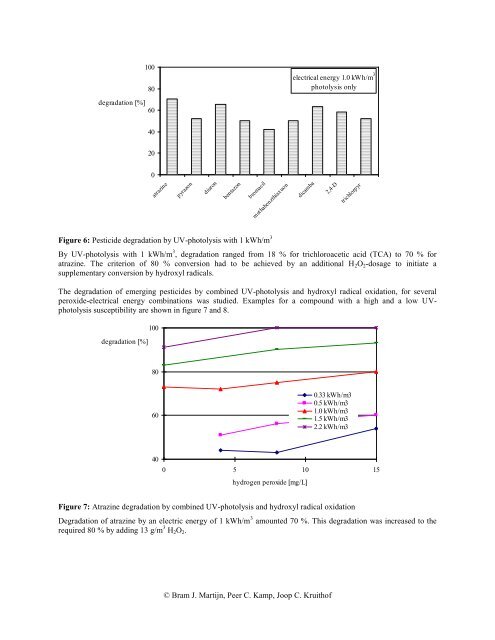UV/H2O2 Treatment an Essential Barrier in a - PWN Technologies
UV/H2O2 Treatment an Essential Barrier in a - PWN Technologies
UV/H2O2 Treatment an Essential Barrier in a - PWN Technologies
You also want an ePaper? Increase the reach of your titles
YUMPU automatically turns print PDFs into web optimized ePapers that Google loves.
100<br />
80<br />
degradation [%]<br />
60<br />
40<br />
20<br />
0<br />
atraz<strong>in</strong>e<br />
pyrazon<br />
diuron<br />
bentazon<br />
bromacil<br />
Figure 6: Pesticide degradation by <strong>UV</strong>-photolysis with 1 kWh/m 3<br />
methabenzthiaxuon<br />
dicamba<br />
© Bram J. Martijn, Peer C. Kamp, Joop C. Kruithof<br />
electrical energy 1.0 kWh/m 3<br />
photolysis only<br />
By <strong>UV</strong>-photolysis with 1 kWh/m 3 , degradation r<strong>an</strong>ged from 18 % for trichloroacetic acid (TCA) to 70 % for<br />
atraz<strong>in</strong>e. The criterion of 80 % conversion had to be achieved by <strong>an</strong> additional <strong>H2O2</strong>-dosage to <strong>in</strong>itiate a<br />
supplementary conversion by hydroxyl radicals.<br />
The degradation of emerg<strong>in</strong>g pesticides by comb<strong>in</strong>ed <strong>UV</strong>-photolysis <strong>an</strong>d hydroxyl radical oxidation, for several<br />
peroxide-electrical energy comb<strong>in</strong>ations was studied. Examples for a compound with a high <strong>an</strong>d a low <strong>UV</strong>photolysis<br />
susceptibility are shown <strong>in</strong> figure 7 <strong>an</strong>d 8.<br />
degradation [%]<br />
100<br />
80<br />
60<br />
40<br />
2,4-D<br />
trichlorpyr<br />
0 5 10 15<br />
hydrogen peroxide [mg/L]<br />
0.33 kWh/m3<br />
0.5 kWh/m3<br />
1.0 kWh/m3<br />
1.5 kWh/m3<br />
2.2 kWh/m3<br />
Figure 7: Atraz<strong>in</strong>e degradation by comb<strong>in</strong>ed <strong>UV</strong>-photolysis <strong>an</strong>d hydroxyl radical oxidation<br />
Degradation of atraz<strong>in</strong>e by <strong>an</strong> electric energy of 1 kWh/m 3 amounted 70 %. This degradation was <strong>in</strong>creased to the<br />
required 80 % by add<strong>in</strong>g 13 g/m 3 <strong>H2O2</strong>.




